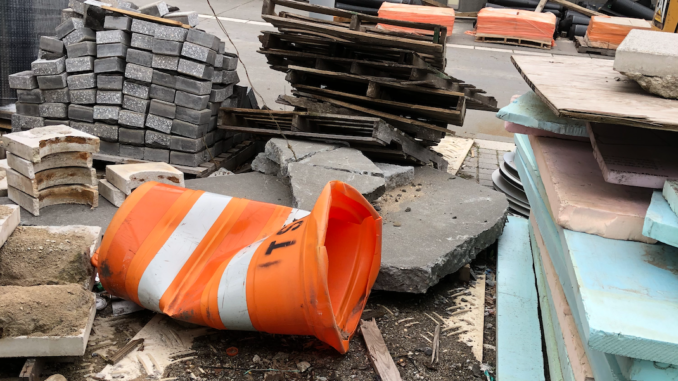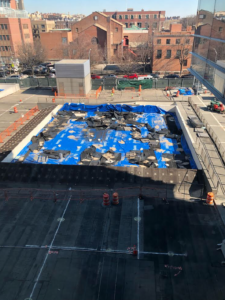
By Kevin Deutsch
[email protected]
The state Dormitory Authority this week declined to make public the amount of taxpayer funds spent to construct the troubled Bronx Hall of Justice, including expenditures on the building’s still-shuttered civic plaza and rooftop rock garden.
Eleven years after the courthouse opened, basic financial records about the project are not being disclosed—despite their inclusion in internal state budget documents.
Instead of releasing the information, a spokesman for the Dormitory Authority—the agency responsible for building the courthouse—said a reporter would be required to submit a Freedom of Information Law Request.
“Upon further review, given the nature of your inquiry, you are going to have to submit a FOIL request,” said David Perritano, Public Information Officer for the Dormitory Authority.
In response, Bronx Justice News submitted a FOIL request Wednesday afternoon. Under state law, the agency has five days to respond.
The Dormitory Authority would not answer questions about whether any of the expenditure information was readily available in agency records. Nor would officials say why a FOIL request was necessary to obtain information included in annual budget and expenditure documents that state agencies are required to maintain.
The withholding of expenditure information comes amid increased scrutiny of the government building following a Bronx Justice News investigation revealing squandered tax dollars and lack of oversight at the property, including construction of a sprawling of “public courtyard” and civic plaza that has never opened to the public.
The Hall of Justice also features a rooftop rock garden, which, like the civic plaza, remains closed to visitors. Lucian Chalfen, Director of Public Information for New York Courts, has said the same safety issues that existed when the courthouse opened—the “ability for people to congregate, secrete weapons and cause mischief” because of design, planning, and staffing issuees—remain today.

Credit: Rafael Viñoly Architects
At the time the courthouse opened, the Dormitory Authority estimated it cost about $421 million to construct. But it has not publicly disclosed the official total, nor how many taxpayer dollars were spent to design and build the shuttered sections.
City Councilman Ritchie Torres, Chairman of the New York City Council Oversight and Investigation Committee, has said he is weighing an official investigative referral in response to the revelations reported by Bronx Justice News.
The office of State Comptroller Thomas P. DiNapoli—New York’s chief fiscal officer and the government official tasked with ensuring state and local governments use taxpayer money effectively and efficiently—has also been monitoring the news coverage.
A litany of issues have plagued the postmodernist courthouse on East 161st Street since it opened in 2008. Among them: $100 million in cost overruns, a three year delay in opening its doors, and a host of lawsuits involving more than 30 parties, from architects and engineers to construction contractors and state agencies, including the Dormitory Authority.
The lowest-bidding contractor on the project was disqualified for suspected mob ties, and problems have been piling up ever since. Among them: a structurally compromised, underground parking garage inspectors once said was in danger of collapse; supposedly bomb and bullet-proof glass panels that routinely break; roof and sewage leaks, flooding, mold, power outages, a mice infestation, broken elevators and escalators; and electrical problems.
The Hall of Justice, which houses the borough’s Supreme Court, is owned and maintained by the city, with the Department of Citywide Administrative Services responsible for day-to-day facilities management.
Far from the idyllic space DCAS assured the public would be open by the end of 2009–complete with evergreen trees and a pedestrian walkway—the plaza today is a desolate, garbage-strewn construction site, much of it covered in tarp and dust.
The courtyard sits atop the courthouse’s underground parking garage, which remained closed for years due to structural problems that, at one point, placed it in danger of collapse.
An ongoing waterproofing project in the courtyard, intended to protect the garage’s ceiling, began in October 2016, according to the City’s Department of Design and Construction, which is overseeing the work. The effort is costing the city about $5.5 million—part of a $40 million project to address a host of problems at the Hall of Justice. Among them: issues with the building’s heating, cooling, and ventilation systems, as well as “conditions that are causing interior glass to break, removal and replacement of defective paint, repair of damaged ductwork in the garage area, and rehabbing of the building’s sewer line and plumbing vent line,” spokesman Ian Michaels said.

The property has also been the site of an accidental death.
A 22-year-old worker died during the construction of the Bronx Hall of Justice—his death triggering more litigation involving the troubled courthouse.
Joao Goncalves was pouring concrete at the East 161st Street site on June 10, 2003 when he fell down an elevator shaft, plunging from the seventh floor onto a second-floor landing, suffering terminal injuries.

Later, a 75-foot canopy at the courthouse’s entrance was removed after inspectors deemed it unstable. The initial inspectors who improperly signed off on the canopy work — Long Island-based Materials Testing Lab—were not certified, officials said at the time.
The matter was referred to the Bronx District Attorney’s Office and U.S. Attorney’s Office in 2007, but no charges were brought.
The project’s construction manager, Bovis Lend Lease, used numerous contractors at the site. The company, one of the world’s largest construction firms at the time, admitted to a massive over billing scheme on New York projects in 2012. They were hit with $56 million in fines and restitution fees as a result.
A different company, Hill International, handled the project’s the final phase.
“While the building, from a design point, looks impressive, its daily functionality obviously is still problematic,” Chalfen said.
Sasha Gonzales and Eric Klein contributed reporting.
